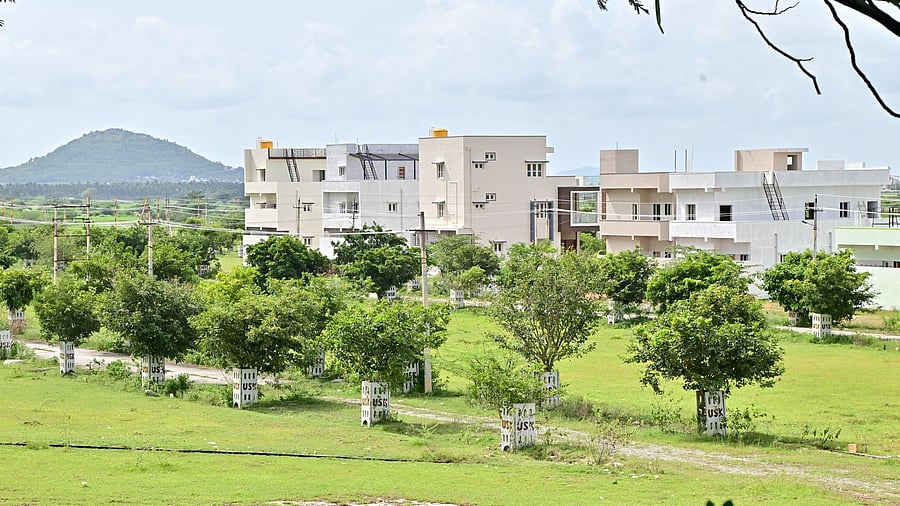
Real Estate – View of Uday Shivakumar Barangay near Kundawada, Davangere.
Credit: Prajavani
The pandemic has transformed our perception of living spaces, highlighting the importance of convenience, self-sufficiency, and a balanced lifestyle. As a result, integrated townships—large, master-planned communities that combine residential, commercial, and recreational facilities—are emerging as attractive investment opportunities, characterised by their stability and long-term potential.
What townships offer
Resilience and stability: Townships are designed as self-sustaining mini-cities, providing a secure environment where residents have access to essential services nearby. During the pandemic, their value became clear as traditional supply chains and mobility were disrupted. For investors, this resilience translates into stability, making townships insulated from market volatility.
Spacious living: The pandemic has increased the demand for spacious homes and green areas. Townships, with their expansive layouts and wellness amenities, cater to this need. According to a recent study, properties within townships have seen a 20-25 per cent rise in interest, signalling a positive trend for investors seeking higher rental yields and capital appreciation.
Community and mental well-being: The pandemic has underscored the importance of community living and mental health. Townships facilitate social interactions through shared spaces such as parks and clubhouses, promoting a sense of belonging. A survey revealed that 72 per cent of homebuyers prioritise mental well-being when choosing properties, highlighting the appeal of townships’ community-oriented designs.
Smart infrastructure and sustainability: Modern townships are increasingly incorporating smart technologies, such as automated security and energy-efficient buildings, making them attractive to tech-savvy buyers. Sustainability is also a critical focus, with features like rainwater harvesting and solar energy becoming standard. As environmental awareness grows, these attributes not only appeal to buyers but also enhance long-term value for investors.
Trending
The demand for large-format townships surged by 35 per cent post-pandemic, reflecting their appeal as safe havens compared to traditional standalone projects. With everything from healthcare to retail within reach, these communities have become indispensable in uncertain times.
In Hyderabad, areas such as Tellapur and Patancheru are becoming key hubs for township developments. The introduction of the Metro phase in Patancheru exemplifies the region’s transformation, enhancing connectivity and attracting residential and commercial growth. This increased accessibility not only raises real estate values but also accelerates overall development, making these areas prime targets for future investments.
In Chennai and Bangalore as well, townships are gaining traction. In Chennai, regions like OMR and ECR have seen property values appreciate by 15-20 per cent, thanks to robust infrastructure and proximity to IT corridors. Similarly, Bangalore’s integrated communities are generating annual returns of 8-12 per cent, driven by steady demand from the tech workforce. Townships offer a holistic lifestyle while minimising reliance on external infrastructure, appealing to both end-users and investors seeking long-term stability and rental income.
With the rapid pace of urbanisation and infrastructure in major cities under strain, townships are emerging as a recourse. Cities like Mumbai, Pune, Chennai, Bangalore, Hyderabad, and Ahmedabad have experienced a notable rise in township projects, with property prices appreciating by 10-25 per cent in key township hubs over the past five years.
Townships in Tier-1 cities have been delivering annual returns of 8-15 per cent, while Tier-2 cities, witnessing swift development, offer substantial capital gains for investors. As India’s middle class continues to expand, preferences are shifting towards convenience, security, and lifestyle amenities, positioning townships as prime investment opportunities that promise long-term growth, steady rental income, and enhanced living standards. Additionally, the integrated nature of these communities makes them more resilient to market fluctuations, providing stability for investors, even in uncertain economic times.
Economic drivers
Urban areas are becoming overcrowded and expensive, prompting buyers to seek alternatives. Townships, typically located on city outskirts, provide a cost-effective solution without sacrificing amenities.
Government initiatives, such as the Smart Cities Mission, along with improved infrastructure like new highways and metro lines, are enhancing the attractiveness of townships. These developments boost property values, with a report indicating that connectivity improvements have increased values by up to 35 per cent in surrounding areas.
The future
In today’s evolving real estate landscape, townships represent a forward-thinking, resilient investment option. Investors increasingly recognise the long-term potential of these developments, which not only promise stability but also align with emerging trends in sustainable and holistic living.
As townships continue to grow, they are set to shape the future of real estate investment, offering a robust model for those seeking both growth and security in a post-pandemic world. With their unique blend of community, convenience, and sustainability, townships are not just a response to current demands—they are a vision for the future of urban living.
(The writer is Chairman & Managing Director of the realty group Incor)